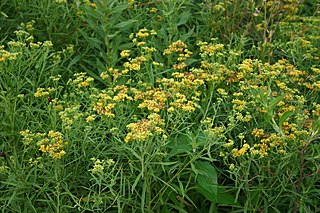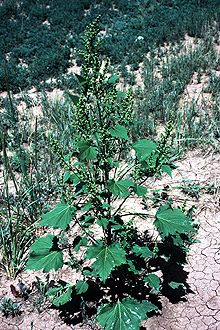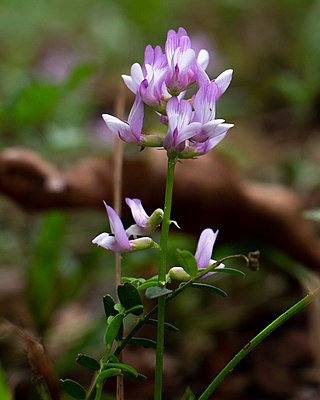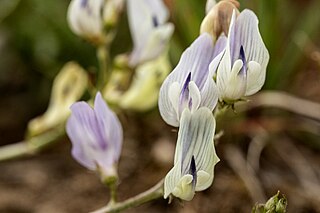Locoweed is a common name in North America for any plant that produces swainsonine, an alkaloid harmful to livestock. Worldwide, swainsonine is produced by a small number of species, most of them in three genera of the flowering plant family Fabaceae: Oxytropis and Astragalus in North America, and Swainsona in Australia. The term locoweed usually refers only to the North American species of Oxytropis and Astragalus, but this article includes the other species as well. Some references may incorrectly list Datura as locoweed.

Coreopsis is a genus of flowering plants in the family Asteraceae. Common names include calliopsis and tickseed, a name shared with various other plants.

Astragalus is a large genus of over 3,000 species of herbs and small shrubs, belonging to the legume family Fabaceae and the subfamily Faboideae. It is the largest genus of plants in terms of described species. The genus is native to temperate regions of the Northern Hemisphere. Common names include milkvetch, locoweed and goat's-thorn. Some pale-flowered vetches are similar in appearance, but they are more vine-like than Astragalus.

Packera is a genus of about 75 species of plants in the daisy family, Asteraceae. Most species are commonly called ragworts or grounsels. Its members were previously included in the genus Senecio, but were moved to a different genus based on chromosome numbers, a variety of morphological characters, and molecular phylogenetic evidence.

Triodanis is a genus of flowering plants within the family Campanulaceae, native to North and South America. Venus' looking-glass is a common name for plants in this genus.

Shepherdia argentea, commonly called silver buffaloberry, bull berry, or thorny buffaloberry, is a species of Shepherdia in the Oleaster family.

Euthamia graminifolia, the grass-leaved goldenrod or flat-top goldenrod, is a North American species of plants in the family Asteraceae.

Colias philodice, the common sulphur or clouded sulphur, is a North American butterfly in the family Pieridae, subfamily Coliadinae.

Orbexilum, commonly called leather-root, is a genus of flowering plants in the legume family (Fabaceae). They are native to North America, where they are found in the United States and Mexico, south to Chiapas.

Sisymbrium linifolium, synonyms including Schoenocrambe linifolia, is a species of flowering plant in the mustard family, known by the common names flaxleaf plainsmustard, skeleton mustard, and Salmon River plains-mustard. It is native to western North America, where it can be found from British Columbia east of the Cascade Range to Saskatchewan in Canada and south to Arizona and New Mexico in the United States. An "extremely common" plant, it is most abundant in the Columbia, Great, and Colorado Basins.

Astragalus molybdenus is a species of flowering plant in the legume family known by the common names Leadville milkvetch and molybdenum milkvetch. It is endemic to Colorado in the United States. If the separate species Astragalus shultziorum and Astragalus lackschewitzii are included in A. molybdenum the range expands into Wyoming and Montana.

Baccharis salicina is a species of plant in the family Asteraceae. Common names include willow baccharis, and Great Plains false willow. It is a shrub found in North America where it grows in mildly saline areas.

Cyclachaena xanthiifolia, known as giant sumpweed, or rag sumpweed is a North American plant species in the sunflower family, Asteraceae. It is the only species in the genus Cyclachaena. Giant sumpweed is believed to be native to the Great Plains but is now found across much of southern Canada and the contiguous United States, though rarely in the Southeast.

Leucospora multifida, known variously as Obi-Wan conobea, narrow-leaved paleseed, cliff conobea, cut-leaved conobea, or much-cleft conobea, is an annual herb in the plantain family, Plantaginaceae, and the only species in the North American genus Leucospora.

Dalea multiflora, commonly called roundhead prairie clover, is a species of flowering plant in the legume family (Fabaceae). It is native to North America, where it is found in Mexico and the United States. In the U.S., it is primarily found in the Great Plains and South Central regions. Its natural habitat is in dry rocky prairies, particularly in limestone soils. It is a conservative species and can be indicative of undisturbed prairie communities.

Astragalus distortus is a species of flowering plant in the legume family known by the common name Ozark milkvetch. It is found in the central United States. Missouri has a wide distribution of this plant, but is uncommon or absent in the northwestern and southeastern sections of the state. The species is subdivided into two varieties, neither of which is particularly common. There is no vine on the plant in Missouri, and it has small, purple inflorescences. Identifying characteristics include its small size, non-vining habit, and its inflorescences. It is a perennial herb. Its habitats include prairies and savannas.

Hypericum tenuifolium, known as Atlantic St. John's-wort and sandhill St. John's-wort, is a species of flowering plant in the St. John's wort family, Hypericaceae. It is native to the Southeastern United States.

Astragalus crassicarpus, known as ground plum or buffalo plum, is a perennial species of flowering plant in the legume family, Fabaceae, native to North America. It was described in 1813. The fruit is edible and was used by Native Americans as food and horse medicine. It is a host of afranius duskywing larvae. It is also known as groundplum milkvetch and pomme de prairie.

Astragalus miser, the timber milkvetch, is a species of flowering plant in the family Fabaceae. A perennial, it is native to western North America, except California. One of the locoweeds toxic to livestock, it contains miserotoxin.

Astragalus shortianus, the early purple milkvetch, is a species of flowering plant in the family Fabaceae. It is native to the west-central United States; Wyoming, Colorado, Nebraska, and New Mexico. A perennial flowering from April through July, it is found growing in dry, rocky soils at elevations from 5,200 to 9,000 ft.




















